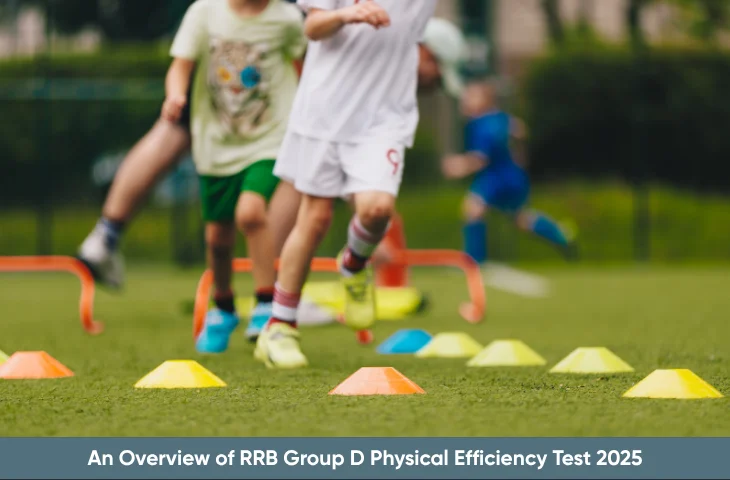Last updated on November 24th, 2025 at 11:10 am
The RRB Group D Physical Efficiency Test (PET) is one of the most crucial stages in the selection process for Railway Level-1 posts. While clearing the Computer-Based Test (CBT) is a major milestone, qualifying the RRB Group D Physical Efficiency Test determines whether a candidate is truly fit for the physically demanding roles of the Indian Railways. In this article, we’ll explore everything about the RRB Group D Physical Efficiency Test 2025, including eligibility, events, standards for male and female candidates, preparation tips, and key takeaways.
Understanding the RRB Group D Physical Efficiency Test
The Physical Efficiency Test (PET) is conducted after the CBT and Document Verification stages. It assesses a candidate’s physical fitness and endurance, ensuring they are capable of handling the operational and field tasks required in Group D roles such as Track Maintainer, Porter, Helper, and Assistant.
It’s a qualifying stage, meaning marks are not awarded – you simply need to meet the prescribed standards to qualify. However, failing to do so leads to disqualification, regardless of your CBT score.
Stages of the RRB Group D Selection Process
Before diving into the PET details, let’s quickly understand the entire selection framework.
| Stage | Details |
| Computer-Based Test (CBT) | Online test with objective questions on General Science, Mathematics, General Intelligence, and Current Affairs. |
| Physical Efficiency Test (PET) | Tests physical fitness of candidates through running and weight-lifting activities. |
| Document Verification | Verification of educational, category, and identity documents. |
| Medical Examination | Ensures candidates meet vision and medical standards. |
RRB Group D Physical Efficiency Test 2025 Key Details
The RRB Group D PET 2025 is expected to follow the same pattern as in the previous recruitment cycle (2019–2022). It consists mainly of two tasks:
- Weight Lifting (Carrying and Lifting Weight)
- Running / 1000 Metres Race
These tasks assess both muscular strength and cardiovascular endurance — two vital attributes for railway maintenance and field work.
Physical Efficiency Standards for Male Candidates
The following table summarizes the PET requirements for male candidates:
| Task | Requirement | Attempts Allowed |
| Weight Lifting | Should lift and carry 35 kg of weight for 100 metres in 2 minutes without putting it down. | Only one chance |
| Running | Should run a distance of 1000 metres in 4 minutes and 15 seconds in one attempt. | Only one chance |
Note: No relaxation is given in timing or distance for any category. Candidates must meet both criteria to qualify.
Physical Efficiency Standards for Female Candidates
The table below shows the Physical Efficiency test details for female candidates:
| Task | Requirement | Attempts Allowed |
| Weight Lifting | Should lift and carry 20 kg of weight for 100 metres in 2 minutes without putting it down. | Only one chance |
| Running | Should run 1000 metres in 5 minutes and 40 seconds in one attempt. | Only one chance |
RRB Group D PET 2025 – Important Guidelines
To ensure fairness and safety, candidates must follow these official PET rules:
- PET will be conducted only for candidates who qualify in CBT and are shortlisted based on merit and cut-off.
- The test will be conducted outdoors, often in stadiums or open grounds under CCTV monitoring.
- Proper sports shoes and comfortable clothing are recommended.
- Candidates suffering from any injury or illness on test day will not get a retest opportunity.
- The test is qualifying in nature — no marks are added to the final merit.
- Candidates must bring medical fitness certificates issued by a government medical officer before appearing.
Role of PET in Railway Job Performance
The RRB Group D roles involve physically demanding activities such as:
- Track inspection and maintenance
- Lifting and moving equipment or tools
- Working outdoors in varying weather
- Continuous walking or standing during duty
Preparation Tips for RRB Group D PET 2025
Candidates must check out the below given tips for qualifying in the RRB Group D PET.
1. Start Early Training
Begin physical training at least 2–3 months before PET. Gradual progress reduces injury risk and enhances performance.
2. Focus on Stamina Building
Running 1000 metres efficiently requires cardiovascular fitness. Practice jogging and interval runs daily.
3. Strength Training
Include push-ups, squats, planks, and resistance exercises to build muscle endurance for the weight-lifting event.
4. Maintain Balanced Nutrition
Consume a protein-rich diet, stay hydrated, and avoid junk food. Proper nutrition supports muscle recovery and energy.
5. Simulate the Test
Rehearse the entire PET setup — lifting weights and running under time constraints. This builds both confidence and rhythm.
6. Rest and Recovery
Avoid overtraining in the last few days. Proper rest ensures muscle efficiency and better performance on test day.
Medical Standards After PET
After qualifying the PET, candidates must pass a medical fitness examination, which includes:
| Category | Vision Standard | Job Suitability |
| A-2 / A-3 | Distant vision: 6/9, 6/12 without glasses | Technical and operational posts |
| B-1 / B-2 | Distant vision: 6/9, 6/12 with glasses | Track Maintainers, Workshop Helpers |
| C-1 / C-2 | Distant vision: 6/12, 6/18 with glasses | Clerical/Non-technical posts |
Summary
The key points of the article are summarized below for the candidates. Check out for a quick overview:
| Aspect | Male Candidates | Female Candidates |
| Weight to Carry | 35 kg for 100 metres | 20 kg for 100 metres |
| Time Limit (Weight Task) | 2 minutes (without setting it down) | 2 minutes (without setting it down) |
| Running Distance | 1000 metres | 1000 metres |
| Time Limit (Running Task) | 4 min 15 sec | 5 min 40 sec |
| Number of Attempts | 1 | 1 |
| Nature of Test | Qualifying only | Qualifying only |
The RRB Group D Physical Efficiency Test 2025 is not merely a formality – it’s a reflection of a candidate’s readiness to take on real-world railway responsibilities. With proper physical preparation, disciplined training, and mental determination, every aspirant can clear the PET with ease.
FAQs
The RRB Group D Physical Efficiency Test is a qualifying physical test conducted after the Computer-Based Test (CBT). It evaluates a candidate’s strength and endurance through activities like weight lifting and running to ensure they are fit for physically demanding railway duties.
Male candidates must:
Lift and carry 35 kg of weight for 100 metres in 2 minutes without putting it down.
Run 1000 metres in 4 minutes and 15 seconds in one go.
Only one attempt is allowed for each event.
Female candidates must:
Lift and carry 20 kg of weight for 100 metres in 2 minutes without putting it down.
Run 1000 metres in 5 minutes and 40 seconds in one attempt.
No relaxation or retest is permitted.
The PET is purely qualifying in nature. No marks are added to the final merit list. However, candidates must pass both tasks (weight lifting and running) to proceed to the next stage – Document Verification and Medical Test.
Begin regular running practice to build stamina.
Do strength training like push-ups, squats, and lifting exercises.
Follow a balanced diet and stay hydrated.
Simulate the test environment to improve timing and confidence.
Avoid overtraining and ensure adequate rest before the test day.
- RRB Technician Study Plan for Working Professional, Know Details
- Top Reasoning Questions for RRB Technician, Download Free PDF
- Important General Science Questions for RRB Technician Exam
- RRB Technician Vacancy Zone Wise, Check Analysis Over Years
- RRB Technician Subject Wise Weightage, Know the Impact of PYP
- RRB Technician Exam Preparation Strategy 2025, Know Details

Hello! This is Arijit Dutta. I am a skilled Content Writer at Oliveboard with nearly 3+ years of experience in crafting engaging, informative, and exam-focused content for the Railways Domain. With a strong command of language and a keen understanding of learner needs, I contribute significantly to Oliveboard’s mission of delivering high-quality educational resources. Passionate about clear communication and continuous learning, I consistently create content that helps government job aspirants achieve their goals. Outside of work, I enjoy playing cricket and listening to music, which helps me stay balanced and creative in my professional journey.
